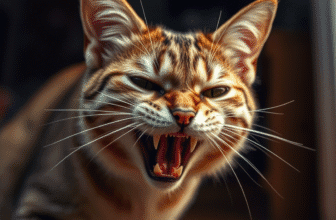
Table of Contents
Ever wondered why your cat starts chirping in a way that’s different from a meow? Cat chirping is a fascinating way cats communicate. It shows us a complex world of feline expression right before our eyes.
Cats have a wide range of sounds, including chirps. These sounds are not just simple meows. They are complex ways cats express emotions, needs, and instincts. From soft trills to rapid chatters, each sound tells a story about your cat’s inner world.
Understanding these sounds can change how you connect with your cat. By learning to interpret their chirps and chatters, you’ll get to know their behavior, emotions, and instincts better. This journey will help you understand your cat’s language, making you a more attuned and responsive pet owner.
As we explore cat chirping, get ready to learn about the science, evolution, and emotions behind these sounds. Your cat has been trying to talk to you all along. Are you ready to listen?
Understanding Cat Communication Basics
Cats have a complex way of talking that’s more than just meows. They use sounds and body language to share their feelings and needs. Learning about cat chirping and other sounds can strengthen your bond with your pet.
Cats talk in many ways, mixing sounds and body signals. Their language is rich, with cat chirping being just one interesting part.
The Evolution of Cat Vocalizations
Cat talk started with wild cats. Domestic cats learned to talk better with humans. Meowing is mainly for talking to people, not for adult cat chats.
- Wild cats use limited vocal communication
- Domestic cats developed more complex sounds
- Cat chirping emerged as a unique communication method
Why Cats Make Different Sounds
Cats make sounds for various reasons. Cat chirping shows excitement, attention, or a hunting urge. Each sound has its own meaning, helping cats share their feelings.
The Role of Body Language in Cat Communication
Body language and sounds work together. A chirp might be with certain tail or ear moves. These signs together show what your cat wants to say.
Understanding your cat’s communication is like learning a unique language – it takes time, patience, and careful observation.
Cat Chirping: A Unique Feline Behavior
Cat chirping is a fascinating sound that surprises many pet owners. You might hear it when your cat watches birds outside. This sound is not a meow but a special way cats communicate.
So, what does cat chirping sound like? It’s a quick, high-pitched series of sounds. These sounds are like a small chirp or a fast chattering noise. Cats make these sounds when they see birds, squirrels, or insects outside.
- Cat chirping often indicates high excitement
- It’s closely linked to hunting instincts
- The sound can express both frustration and anticipation
Experts think cat chirping comes from their wild ancestors. These short, staccato sounds might be an involuntary response triggered by the sight of potential prey. Some say it’s a way cats practice hunting or show excitement for the hunt.
Every cat is unique, and this behavior gives us a peek into their world. Notice when and how your cat chirps. It might help you understand their personality better.
The Science Behind Cat Vocalizations
Cat chirping is a fascinating phenomenon that stems from complex physiological processes. Your feline friend’s ability to produce unique sounds involves intricate biological mechanisms. These go beyond simple meowing.
Cats have an extraordinary vocal system that lets them create a wide range of sounds. Their vocal anatomy is remarkably sophisticated. It enables precise sound production through specialized structures.
How Cats Produce Sounds
The process of cat chirping begins deep within their respiratory and vocal systems. Cats generate sounds through a combination of:
- Air movement through vocal cords
- Muscle control in the larynx
- Precise tongue and mouth positioning
The Anatomy of Cat Vocal Cords
Unlike humans, cats have uniquely structured vocal cords. These are shorter and more flexible. This difference enables them to produce high-pitched cat chirping sounds with remarkable precision.
Brain Activity During Vocalization
Neurological research shows that cat chirping involves specific brain regions. These are responsible for communication and emotional expression. When your cat chirps, multiple neural pathways activate simultaneously. This creates a complex vocal response.
“Cat vocalizations are a sophisticated form of communication that reflects intricate neurological processes.” – Feline Behavior Research Institute
Understanding the science behind cat chirping helps you appreciate your feline companion’s remarkable communication skills.
When and Why Cats Chirp
Cat chirping is a fascinating sound that shows a lot about your cat’s feelings. It’s different from regular meows. It’s a special way cats talk to each other, linked to hunting and socializing.
To understand cat chirping, we need to look at a few important situations:
- When observing potential prey through windows
- During interactions with kittens
- As a method of catching human attention
- While experiencing excitement or anticipation
Studies say cat chirping comes from their hunting instincts. When your cat sees a bird or small animal outside, it chirps. This sound is like a hunting call, showing excitement and frustration.
Mother cats chirp to talk to their kittens. The chirps are soft and high-pitched. They help guide and call the kittens, showing a caring side of this sound.
“Cats communicate through a complex language of sounds, with chirping being one of their most nuanced expressions.” – Feline Behavior Experts
Your cat’s chirping can change based on their personality, breed, and surroundings. Watching how they act and what they do can help you understand what they mean.
Chattering: The Hunter’s Instinct
Cat chirping shows a fascinating side of your feline’s hunting nature. When your cat chirps, it’s a sign of their deep hunting instincts.
Cats feel a strong emotional rush when they see prey. This chirping is not just a sound. It’s a survival skill passed down from their wild ancestors.
Predatory Behavior Patterns
During these chirping moments, your cat shows certain behaviors:
- Rapid jaw movements
- Focused gaze on potential prey
- Heightened muscular tension
- Increased sensory alertness
Connection to Wild Cat Ancestors
Wild cats like leopards and tigers also chirp like this. Your domestic cat’s chirping comes from these wild predators. It shows their instinctive hunting ways.
Emotional States During Chattering
Cat chirping usually means excitement and frustration. When your cat can’t catch its target, it chirps. This sound shows anticipatory energy and excitement to hunt.
Veterinary behaviorists say cat chirping is a complex emotional response linked to hunting strategies.
Different Types of Cat Meows and Their Meanings

Cat chirping is just one fascinating aspect of feline communication. Your cat’s vocal repertoire is incredibly complex, with different meows serving unique purposes. Understanding these sounds can help you better interpret your furry friend’s emotional state and needs.
Cats use a wide range of vocalizations to express themselves. Some meows are soft and melodic, while others can be sharp and demanding. Each sound carries a specific message that goes beyond simple cat chirping.
- Short, high-pitched meows typically indicate greeting or excitement
- Low-pitched, drawn-out meows often signal discomfort or complaint
- Rapid, staccato chirps might represent hunting excitement or attention-seeking behavior
- Soft trills usually communicate affection or maternal care
Veterinary researchers have identified several distinct meow categories that reveal your cat’s internal state. The pitch, duration, and volume of these sounds provide crucial insights into their emotional world.
| Meow Type | Typical Meaning | Emotional Context |
|---|---|---|
| Chirping | Prey attraction | Hunting instinct |
| Purring Meow | Contentment | Relaxation |
| Loud Meow | Demand for attention | Urgency |
“Cats speak volumes without saying a word. Their meows are a language all their own.” – Dr. Sarah Mitchell, Feline Behavior Specialist
Your ability to recognize and respond to these nuanced vocalizations can strengthen the bond with your cat. It transforms simple cat chirping into meaningful communication.
The Difference Between Chirping and Trilling
Cat chirping and trilling might sound the same, but they’re different ways cats talk. Knowing these differences helps you understand what your cat is trying to say.
Cats make many sounds to talk to each other. Chirping and trilling are two interesting ways they communicate. Even though they sound alike, each has its own meaning and use.
Maternal Origins of Trilling
Trilling comes from how mother cats talk to their kittens. They use this high-pitched sound to:
- Get their kittens’ attention
- Signal safety and comfort
- Guide young kittens during early development
As kittens grow up, they keep using this sound. It changes from a way for mothers to talk to their kittens to a way for cats to talk to each other.
Social Aspects of These Sounds
The way cats use chirping and trilling is different. Trilling is like a friendly greeting. Chirping is more about hunting or excitement.
When your cat trills at you, it’s a good sign. It means they’re happy to see you and want to play or talk.
By understanding these sounds, you can get closer to your cat. You’ll know what they’re trying to say better.
Understanding Your Cat’s Emotional State Through Sounds
Cat chirping shows a complex emotional side that’s more than just meows. Your cat shares deep feelings through special sounds. Cat chirping is like a detailed emotional language.
Knowing these sounds lets you understand your cat’s feelings better. Different chirps mean different emotions:
- Excitement: Sharp, quick chirps show enthusiasm
- Frustration: Repetitive chirping might mean they’re feeling tense
- Contentment: Soft, gentle chirps usually mean they’re happy
Cats use chirping as a smart way to talk to us. When they chirp, they’re trying to get your attention or share a feeling. Experts say these sounds come from their social nature.
Listening to the context, pitch, and frequency of chirping can tell you a lot about your cat’s mood. Each chirp opens a window into their feelings. This helps you meet their needs better.
“A cat’s chirp is more than just a sound—it’s a conversation.” – Feline Behavior Experts
By learning to understand these sounds, you’ll connect with your cat on a deeper level. This builds a more caring bond between you.
Common Situations That Trigger Cat Chirping
Cat chirping is a fascinating way for cats to communicate. It shows a lot about what they’re feeling and thinking. Knowing when they chirp can help you understand them better.
Cats chirp for two main reasons: when they see prey and during social times. These sounds are not just random. They are complex signals that show their instincts and emotions.
Prey-Related Chirping
When cats see prey, like birds or squirrels, they chirp a lot. This mimics the hunting movements they would make. You might hear them chirp when they watch:
- Birds fluttering near a window
- Squirrels scampering across a yard
- Small insects moving quickly
“The chirping sound is essentially a frustrated hunting response,” says feline behavior expert Dr. Sarah Thompson.
Social Interaction Chirps
Cat chirping isn’t just for hunting. They also chirp when they’re happy to see you or want to play. Your cat might chirp when:
- Greeting you after a long absence
- Seeking attention or playtime
- Expressing excitement about food
Each chirp has its own emotional message. It shows how smart and communicative our cats are.
How Different Cat Breeds Vocalize
Cat chirping changes a lot between different breeds. Some cats talk a lot, while others are quiet. Knowing your cat’s breed helps you understand their special sounds and chirps.
Some breeds are known for their great talking skills. Siamese cats, for example, are famous for their loud and constant talking. They make sounds that can sound like music.
- Siamese: Extremely vocal with frequent chirping and meowing
- Abyssinian: Playful chirpers with energetic communication styles
- Maine Coon: Known for soft chirps and trills
- Bengal: Often exhibit excited cat chirping during hunting-like play
Your cat’s breed affects how often and how they chirp. Smaller cats chirp higher, while bigger cats chirp deeper.
Genetics also play a big part in a cat’s talking habits. Some breeds are bred to talk more, so they chat more with people.
Understanding your cat’s breed-specific communication can strengthen your bond and improve mutual understanding.
Every cat is different, and their chirps show their unique personality. Watching how your cat talks helps you understand them better.
The Link Between Age and Cat Vocalizations
Cat chirping and vocalizations change a lot as they grow older. Knowing these changes helps you talk better with your cat at every age.
As cats get older, how they talk changes too. Kittens and older cats have special ways of making sounds. These sounds show how they’re growing and thinking.
Kitten Communications
Kittens start making sounds with soft, high-pitched noises. They chirp a lot and playfully. Their chirping does many things:
- It gets mom’s attention
- It shows they’re hungry or not feeling well
- It helps them practice talking
Young cats chirp a lot to talk and learn. They try different sounds to communicate.
Senior Cat Sound Changes
Older cats’ sounds can change a lot. This can happen for many reasons:
- They might not think as clearly
- They might not hear as well
- They might have health problems
Vets say to watch for these sound changes. They can mean there’s something wrong with their health.
| Cat Life Stage | Vocalization Characteristics | Communication Purpose |
|---|---|---|
| Kitten (0-6 months) | High-pitched, frequent chirping | Bonding, learning, seeking attention |
| Adult (1-8 years) | Balanced, purposeful vocalizations | Social interaction, expressing needs |
| Senior (9+ years) | Potentially more frequent, varied sounds | Communicating discomfort, cognitive changes |
Remember, every cat is different. It’s normal for them to sound unique.
Health Issues That May Affect Cat Sounds

Your cat’s sounds can mean more than just cute noises. Changes in chirping or other sounds might show health problems. Knowing these signs can help keep your cat healthy.
Vets often see health issues that change a cat’s sounds. Cat chirping might change or become irregular with certain health problems.
- Respiratory infections affecting vocal cord function
- Thyroid disorders causing vocal changes
- Neurological conditions impacting sound production
- Dental problems creating discomfort during vocalization
Some health issues can really change your cat’s chirping. Sudden changes in pitch, frequency, or volume might mean health problems need a vet’s check.
Look out for these signs:
- Persistent hoarseness
- Unusual silence
- Painful-sounding vocalizations
- Excessive cat chirping without apparent trigger
Regular vet visits can spot health issues early. If your cat’s chirping changes a lot, get a vet to check their health.
Remember, your cat’s sounds are a critical communication tool that can reveal important health information.
While cat chirping is usually normal, don’t ignore big changes. Paying close attention can help catch health problems early.
Responding to Your Cat’s Chirps and Chatters
Cat chirping is a fascinating way for cats to communicate. It can make your bond with your cat stronger. Learning how to respond to these sounds can improve your relationship and give you insight into your cat’s feelings.
When your cat chirps, it’s important to notice the situation and their body language. Cat chirping can show different feelings, like excitement or a hunting urge.
Effective Communication Strategies
To connect better with your cat, try these response methods:
- Watch the situation before you respond
- Match your cat’s energy level
- Speak softly when chirping back
- Avoid sudden moves that might scare your cat
Appropriate Response Techniques
Each cat chirping situation needs a special approach:
- Prey-related chirping: Play with a toy to mimic hunting
- Social chirps: Say something gentle
- Attention-seeking chirps: Give a quick playtime or interaction
Every cat is different. Listen to your cat’s unique way of communicating. Cat chirping is a special way for them to connect with you. So, enjoy these moments of connection.
Training and Behavioral Modifications
Cat chirping is a fascinating behavior that can sometimes become overwhelming for pet owners. Understanding how to manage and modify this vocalization requires patience and strategic approach.
When your cat’s cat chirping becomes excessive, you’ll want to implement targeted training techniques. These strategies help redirect your cat’s communication patterns while respecting their natural instincts.
- Identify trigger points for cat chirping
- Create a calm environment
- Use positive reinforcement techniques
- Provide mental stimulation
Behavioral modification starts with understanding the root cause of your cat’s chirping. Stress, excitement, or hunting instincts can drive this vocalization. By addressing these underlying factors, you can help reduce unnecessary chirping.
| Behavior Modification Strategy | Effectiveness |
|---|---|
| Interactive Play Sessions | High |
| Environmental Enrichment | Medium to High |
| Consistent Training | High |
Professional cat behaviorists recommend gradual training methods. Reward quiet behavior with treats and attention. Avoid punishing your cat for chirping, as this can increase anxiety and potentially worsen vocalization.
“Understanding your cat’s communication is key to successful behavioral modification.” – Feline Behavior Experts
Remember that each cat is unique. What works for one might not work for another. Patience and consistent approach are crucial in managing your cat’s chirping behavior.
When to Consult a Veterinarian About Cat Sounds

Knowing when your cat’s sounds, like chirping, might mean they’re sick is key. Not every change in sound is a big deal. But some could be signs of a serious issue that needs a vet’s help.
Keep an eye out for sudden changes in how your cat sounds. If their chirping seems off, it might be a sign of trouble. You should see a vet if you notice:
- Persistent or excessive cat chirping
- Sudden changes in vocal volume or frequency
- Sounds accompanied by visible discomfort
- Vocal changes paired with behavioral modifications
Your cat’s sounds can tell you a lot about their health. Issues like breathing problems, neurological issues, or pain can show up in their sounds. Older cats might also have age-related changes that need a vet’s check.
Look out for these signs that mean you should see a vet right away:
- Wheezing or raspy cat chirping
- Sounds indicating potential respiratory distress
- Vocal changes combined with lethargy
- Unexplained weight loss or appetite changes
Trust your gut. If your cat’s sounds seem off, getting a vet’s opinion is a good idea. It’s the best way to make sure your cat stays healthy.
Conclusion
Understanding cat chirping opens a fascinating window into your feline companion’s complex communication system. These unique vocalizations reveal much more than simple sounds. They are a sophisticated language that connects you directly to your cat’s inner world. By learning to interpret cat chirping, you gain insights into their emotions, instincts, and social interactions.
Cat chirping represents a remarkable blend of biological instinct and emotional expression. Whether triggered by hunting impulses or social engagement, these sounds provide valuable clues about your cat’s state of mind. Paying close attention to the context and frequency of cat chirping can help you respond more effectively to your pet’s needs and strengthen your bond.
Your journey into understanding feline communication doesn’t end here. Each chirp, chatter, and meow is an opportunity to deepen your relationship with your cat. By remaining observant and responsive, you’ll develop a more nuanced connection that goes beyond words. This creates a profound and intuitive understanding between you and your furry companion.
Embracing the complexity of cat chirping means recognizing that your cat is constantly communicating. Your willingness to listen and learn will transform your interactions. Making every chirp a moment of connection and mutual understanding.
FAQ
Why do cats chirp?
Cats chirp to communicate, often showing excitement or hunting instincts. It can mean they see prey, are excited, or want attention.
Is chirping different from meowing?
Yes, chirping is different from meowing. Meows are for humans, while chirping is a unique sound. It’s linked to excitement or communication.
Do all cats chirp?
Not all cats chirp the same. Some are more vocal, and it depends on breed, personality, and environment.
What does cat chattering mean?
Chattering means a cat is excited to hunt. They chatter teeth at birds or small animals. It’s an instinctive response.
Is chirping a sign of a health problem?
Usually, chirping is normal. But, sudden changes or too much chirping might mean health issues. See a vet if worried.
How can I respond when my cat chirps?
Just observe and acknowledge your cat. Talk softly, make eye contact, or see what’s causing the chirping. Don’t scare or punish them.
Do kittens chirp differently from adult cats?
Kittens chirp less as they grow. Their chirping becomes more purposeful with age, tied to emotions or environment.
Can indoor cats chirp at things they can’t catch?
Yes! Indoor cats chirp at birds or animals outside. It’s their hunting instinct, even when they can’t catch them.
Are some cat breeds more likely to chirp?
Some breeds like Abyssinians, Bengals, and Maine Coons are more vocal. They might chirp more than others.
Is chirping a form of communication with humans?
Chirping is a way cats talk to humans. They use it to get attention, show excitement, or want to interact. Each cat has its own way of communicating.







